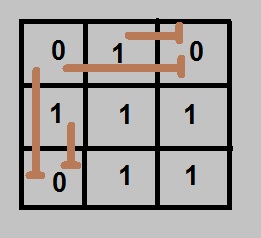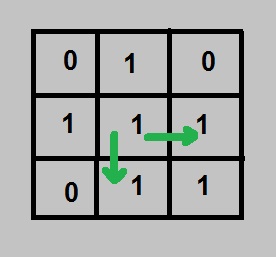给定一个二元 N x N 矩阵,我们需要找到从其存在无限路径的矩阵位置总数。当且仅当位置 (i, j) 具有值 1 并且其行 (i) 及其列 (j) 中的所有下一个位置都应具有值 1 时,才称任何位置 (i, j) 具有无限路径. 如果在行 (i) 或列 (j) 中 (i, j) 旁边的任何位置都为 0,则位置 (i, j) 没有任何无限路径。
例子:
Input : 0 1 0
1 1 1
0 1 1
Output : 4
Endless points are (1, 1), (1, 2),
(2, 1) and (2, 2). For all other
points path to some corner is
blocked at some point.
Input : 0 1 1
1 1 0
0 1 0
Output : 1
Endless point is (0, 1).天真的方法:
我们遍历所有位置,对于每个位置,我们检查这个位置是否有无限路径。如果是,则计算它,否则忽略它。但像往常一样,它的时间复杂度似乎很高。
时间复杂度: O(n 3 )
高级方法(动态编程):
我们可以很容易地说,如果任何位置都有一个零,那么它将阻塞它左边和上面的所有位置的路径。

此外,如果 (i,j+1) 将有无限行并且 (i, j) 的值为 1,我们可以说任何位置 (i,j) 将有无限行。
类似地,如果 (i+1,j) 将有一个无限列并且 (i, j) 的值为 1,我们可以说任何位置 (i,j) 将有一个无限列。

所以我们应该维护两个矩阵,一个用于行,一个用于列。始终从行的最右位置和列的最底部位置开始,仅检查下一个位置是否有无限路径。
最后,如果任何位置在行矩阵和列矩阵中都有无限路径,则称该位置具有无限路径。
C++
// C++ program to find count of endless points
#include
using namespace std;
const int MAX = 100;
// Returns count of endless points
int countEndless(bool input[][MAX], int n)
{
bool row[n][n], col[n][n];
// Fills column matrix. For every column, start
// from every last row and fill every entry as
// blockage after a 0 is found.
for (int j=0; j=0; i--)
{
// encountered a '0', set the isEndless
// variable to false
if (input[i][j] == 0)
isEndless = 0;
col[i][j] = isEndless;
}
}
// Similarly, fill row matrix
for (int i=0; i=0; j--)
{
if (input[i][j] == 0)
isEndless = 0;
row[i][j] = isEndless;
}
}
// Calculate total count of endless points
int ans = 0;
for (int i=0; i Java
// Java program to find count of endless points
class GFG {
static final int MAX = 100;
// Returns count of endless points
static int countEndless(boolean input[][], int n)
{
boolean row[][] = new boolean[n][n];
boolean col[][] = new boolean[n][n];
// Fills column matrix. For every column,
// start from every last row and fill every
// entry as blockage after a 0 is found.
for (int j = 0; j < n; j++)
{
// flag which will be zero once we get
// a '0' and it will be 1 otherwise
boolean isEndless = true;
for (int i = n-1; i >= 0; i--)
{
// encountered a '0', set the
// isEndless variable to false
if (input[i][j] == false)
isEndless = false;
col[i][j] = isEndless;
}
}
// Similarly, fill row matrix
for (int i = 0; i < n; i++)
{
boolean isEndless = true;
for (int j = n-1; j >= 0; j--)
{
if (input[i][j] == false)
isEndless = false;
row[i][j] = isEndless;
}
}
// Calculate total count of endless points
int ans = 0;
for (int i = 0; i < n; i++)
for (int j = 1; j < n; j++)
// If there is NO blockage in row
// or column after this point,
// increment result.
if (row[i][j] && col[i][j])
ans++;
return ans;
}
//driver code
public static void main(String arg[])
{
boolean input[][] = {
{true, false, true, true},
{false, true, true, true},
{true, true, true, true},
{false, true, true, false}};
int n = 4;
System.out.print(countEndless(input, n));
}
}
// This code is contributed by Anant Agarwal.Python3
# Python3 program to find count of
# endless points
import numpy as np
# Returns count of endless points
def countEndless(input_mat, n) :
row = np.zeros((n, n))
col = np.zeros((n, n))
# Fills column matrix. For every column,
# start from every last row and fill
# every entry as blockage after a 0 is found.
for j in range(n) :
# flag which will be zero once we
# get a '0' and it will be 1 otherwise
isEndless = 1
for i in range(n - 1, -1, -1) :
# encountered a '0', set the
# isEndless variable to false
if (input_mat[i][j] == 0) :
isEndless = 0
col[i][j] = isEndless
# Similarly, fill row matrix
for i in range(n) :
isEndless = 1
for j in range(n - 1, -1, -1) :
if (input_mat[i][j] == 0) :
isEndless = 0
row[i][j] = isEndless
# Calculate total count of endless points
ans = 0
for i in range(n) :
for j in range(1, n) :
# If there is NO blockage in row
# or column after this point,
# increment result.
#print(row[i][j] , col[i][j])
if (row[i][j] and col[i][j]) :
ans += 1
#print(ans)
return ans
# Driver code
if __name__ == "__main__" :
input_mat = [[1, 0, 1, 1],
[0, 1, 1, 1],
[1, 1, 1, 1],
[0, 1, 1, 0]]
n = 4
print(countEndless(input_mat, n))
# This code is contributed by RyugaC#
// C# program to find count of
// endless points
using System;
public class GFG {
// Returns count of endless points
static int countEndless(bool [,]input, int n)
{
bool [,]row = new bool[n,n];
bool [,]col = new bool[n,n];
// Fills column matrix. For every
// column, start from every last
// row and fill every entry as
// blockage after a 0 is found.
for (int j = 0; j < n; j++)
{
// flag which will be zero
// once we get a '0' and it
// will be 1 otherwise
bool isEndless = true;
for (int i = n - 1; i >= 0; i--)
{
// encountered a '0', set
// the isEndless variable
// to false
if (input[i,j] == false)
isEndless = false;
col[i,j] = isEndless;
}
}
// Similarly, fill row matrix
for (int i = 0; i < n; i++)
{
bool isEndless = true;
for (int j = n - 1; j >= 0; j--)
{
if (input[i,j] == false)
isEndless = false;
row[i,j] = isEndless;
}
}
// Calculate total count of
// endless points
int ans = 0;
for (int i = 0; i < n; i++)
for (int j = 1; j < n; j++)
// If there is NO blockage
// in row or column after
// this point, increment
// result.
if (row[i,j] && col[i,j])
ans++;
return ans;
}
//Driver code
public static void Main()
{
bool [,]input = {
{true, false, true, true},
{false, true, true, true},
{true, true, true, true},
{false, true, true, false}};
int n = 4;
Console.Write(countEndless(input, n));
}
}
// This code is contributed by Sam007.PHP
= 0; $i--)
{
// encountered a '0',
// set the isEndless
// variable to false
if ($input[$i][$j] == 0)
$isEndless = 0;
$col[$i][$j] = $isEndless;
}
}
// Similarly, fill row matrix
for ($i = 0; $i < $n; $i++)
{
$isEndless = 1;
for ($j = $n - 1; $j >= 0; $j--)
{
if ($input[$i][$j] == 0)
$isEndless = 0;
$row[$i][$j] = $isEndless;
}
}
// Calculate total count
// of endless points
$ans = 0;
for ($i = 0; $i < $n; $i++)
for ($j = 1; $j < $n; $j++)
// If there is NO blockage
// or column after this point,
// increment result.
if ($row[$i][$j] &&
$col[$i][$j])
$ans++;
return $ans;
}
// Driver code
$input = array(array(1, 0, 1, 1),
array(0, 1, 1, 1),
array(1, 1, 1, 1),
array(0, 1, 1, 0));
$n = 4;
echo countEndless($input, $n);
// This code is contributed
// by shiv_bhakt.
?>Javascript
输出:
5如果您希望与专家一起参加现场课程,请参阅DSA 现场工作专业课程和学生竞争性编程现场课程。